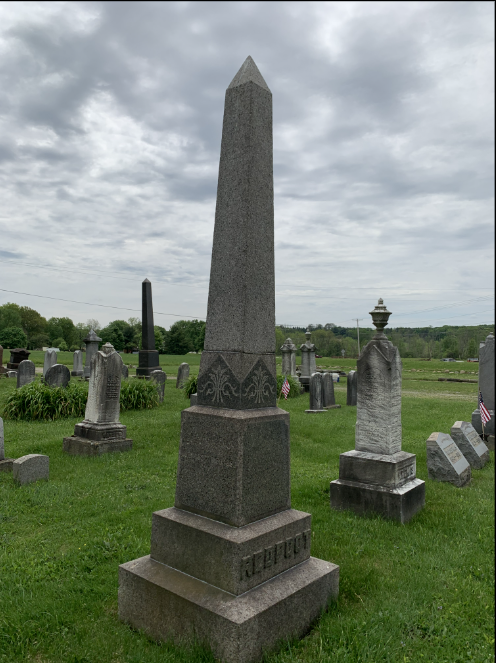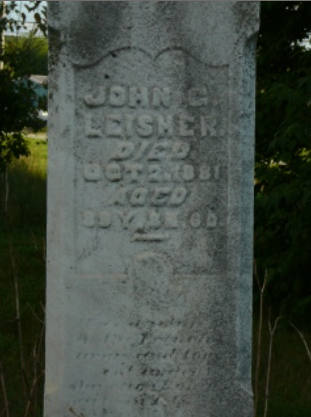Echoes of the Past: Notable Graves of St. John’s Cemetery in Delaware Grove, PA
- Scarly

- Jul 24
- 4 min read
Nestled amid the rolling farmland of Delaware Township, St. John’s Cemetery, also known as Delaware Township Cemetery, serves as a quiet but powerful monument to the people who once called Mercer County home. Its soil holds not only the remains of settlers, farmers, veterans, and ministers but the very stories that shaped a community. Tied intimately to the early German and Swiss immigrants of the region and the spiritual heartbeat of St. John’s Church, the cemetery breathes history with every lichen-covered headstone.
It is here that Bodhi’s newest addition, The Reliquary, rises in reverence, a Gothic cathedral flanked by this sacred ground. Together, they form a sanctuary of memory, grief, and quiet awe.
A Cemetery of Stories Carved in Stone
Among the 367 known graves, some are marked by elaborate monuments, others by hand-carved stones with inscriptions in the old German tongue. Each stone bears witness to lives lived with purpose and perseverance. Some celebrate enduring love; others whisper of tragedy, sacrifice, and resilience. As you walk the rows, the boundary between past and present thins, it’s a place where history lives on in the stillness.
Families Rooted in the Land
The Reichard Family, with fifteen members interred here, is one of the cemetery’s most established lineages. Henry Reichard Sr. (1765–1845), born in Weisenberg Township, and his wife Maria Magdalena Acker (1775–1847) were among the early settlers from Northampton County. Together, they raised nine children and planted the roots of a legacy that would shape the township for generations.
Standing tall over Gottlieb Redfoot’s resting place is a commanding monument, shared with his wife Sophia Friederike Ruff Redfoot. Both were born in Baden-Württemberg, Germany, and married in 1858 before immigrating to the United States. Parents of eleven children, their story is one of courage and migration, carving a new life from the Pennsylvania wilderness while preserving the customs of their homeland.
Another remarkable life remembered here is that of Susanna Fox Sponsler, born in 1797 in York County. A devout Lutheran, Susanna was confirmed at 14 and later undertook a difficult journey on foot to Ohio in 1817, there were no roads, no bridges. A year later, she married Henry Sponsler, with whom she shared 50 years of marriage and raised eight children. At the time of her death, she was grandmother to 46 and great-grandmother to 56, an enduring matriarch of early American settlement.

Grace, Tragedy, and the Passage of Time
Rebecca May Catherine “Kitty” Trine Lesher, born in 1826, was known as the oldest living resident of Sharon at the time of her passing in 1919 at age 93. Her long life, lived almost entirely in Mercer County, spanned a time of dramatic change, from horse-drawn wagons to electric streetcars.
Anna “Annie” Anderson Kaufman, born in Ireland in 1807, rests here as the cemetery’s only known Irish-born resident. She is buried beside her husband, Henry G. Kaufman, bridging continents and cultures in a final, peaceful union.
In contrast, the grave of Harry Wagenman tells a tale of heartbreak. Born in 1881, he died at just ten years old from diphtheria, a once-common illness that devastated families before the age of vaccines. Though three of his siblings were also infected, they survived. His short life is a reminder of the fragility of childhood in the 19th century.

The Shepherd of Souls: Rev. Philip Zeiser
One of the most influential figures buried at St. John’s is Rev. Philip Zeiser, born in 1802 in Schallbach, Lorraine, France. After immigrating to America in 1819, Zeiser became the first German Reformed minister to serve Crawford and Mercer Counties. A pioneer in every sense, he helped found both St. John’s Church and the cemetery alongside Rev. Michael Kuchler. In 1848, illness forced him to retire from active ministry, and he passed away in 1875. His legacy, however, is woven into the spiritual fabric of the region.

The Soldiers Who Rest
St. John’s Cemetery is home to many veterans, including those who fought in the bloodiest conflict in American history, the Civil War.
John Schell, a veteran of the 57th Regiment, Pennsylvania Volunteer Infantry, served with distinction in a war that claimed more than 750,000 lives.
Brothers Jacob and Samuel Moyer also answered the call, both serving their country with honor.
Christian King proudly served in the U.S. Navy, a maritime defender of the Union cause.
One of the most haunting stories is that of Edwin Hoffman, a veteran who survived the war only to meet a tragic end. While gathering firewood with his brother Tilghman, a falling tree branch struck him in the head, fracturing his skull and scattering brain tissue, a grisly and sudden death at age 37. He left behind a wife and four children.
And then there is John George Leisher, born in France in 1792. A soldier under Napoleon Bonaparte and a survivor of the Battle of Waterloo, he swam across the Katzebuch River while clinging to a horse’s tail to escape enemy fire. Later, he fought alongside Lafayette in the Battle of New Orleans. After arriving in America in 1817, he made Pennsylvania his home for the next 48 years. He is buried here with his wife Susanna Dettmer Leisher, two lives joined by history, heroism, and devotion.


Holding Space for the Dead
A walk through St. John’s Cemetery is not just an act of remembrance. It is an invitation to bear witness. These stories, carved in stone and softened by time, evoke images of mothers giving birth without medical care, children succumbing to illness, and families sacrificing sons to war. Behind every name lies a human life, one that breathed, hoped, suffered, and loved.
Adopt a Grave: A Tangible Act of Remembrance
As part of The Blue Bodhi’s “Adopt‑a‑Grave” campaign, visitors now have the opportunity to preserve this sacred space and help restore its weathered memorials. Adopting a grave, whether it’s your ancestor or a story that touched your heart, is a tangible act of connection and respect.
🔗 Explore graves available for adoption here: https://www.thebluebodhi.com/search?q=adopt+a+grave
Closing Reflections
In honoring the past, we illuminate the path ahead. Cemeteries like St. John’s are not forgotten relics but active vessels of memory, community, and reverence. To walk among these graves is to walk beside the pioneers, preachers, mothers, soldiers, and children who shaped this land. Through remembrance, we not only honor them, we remember ourselves.



Comments